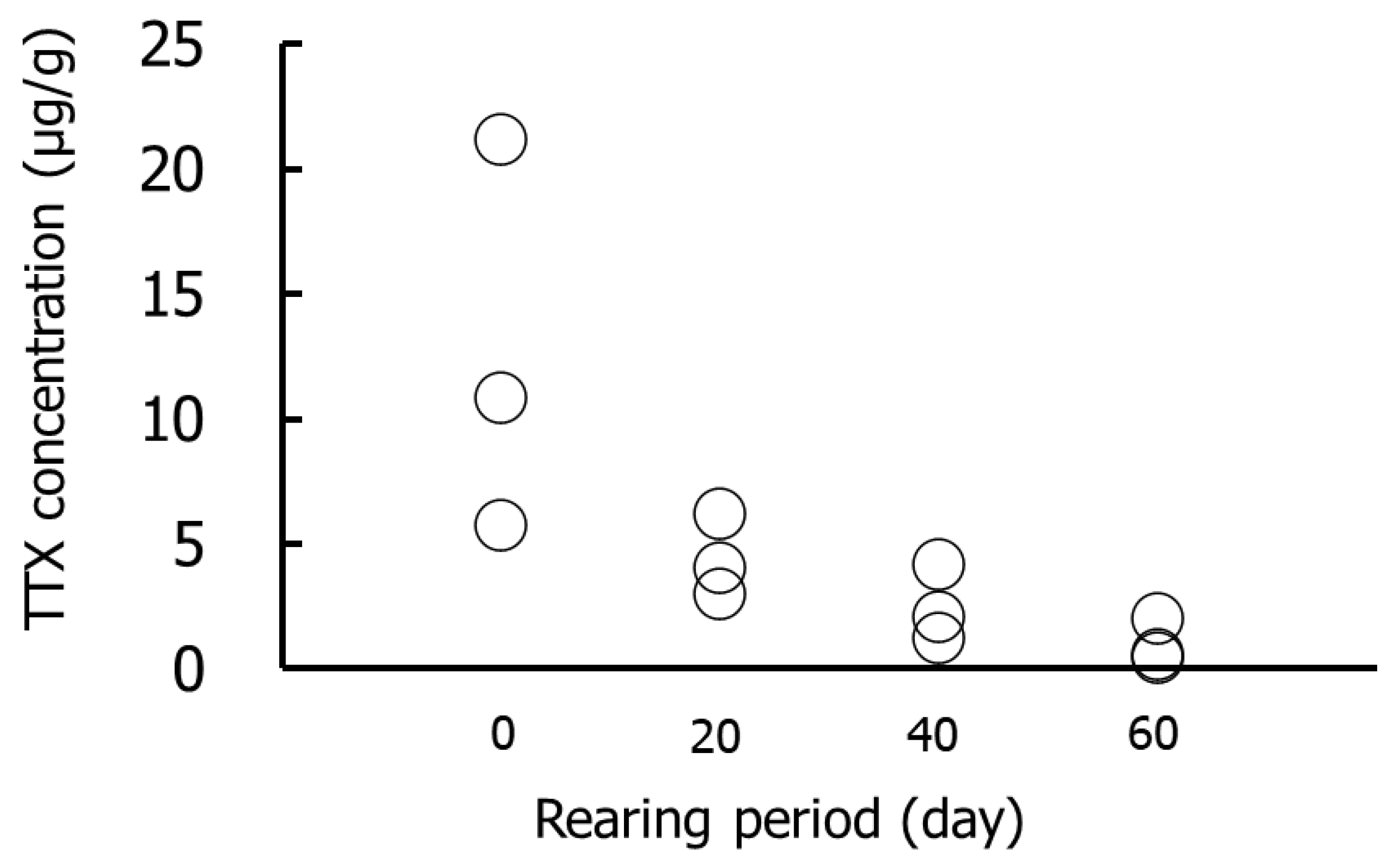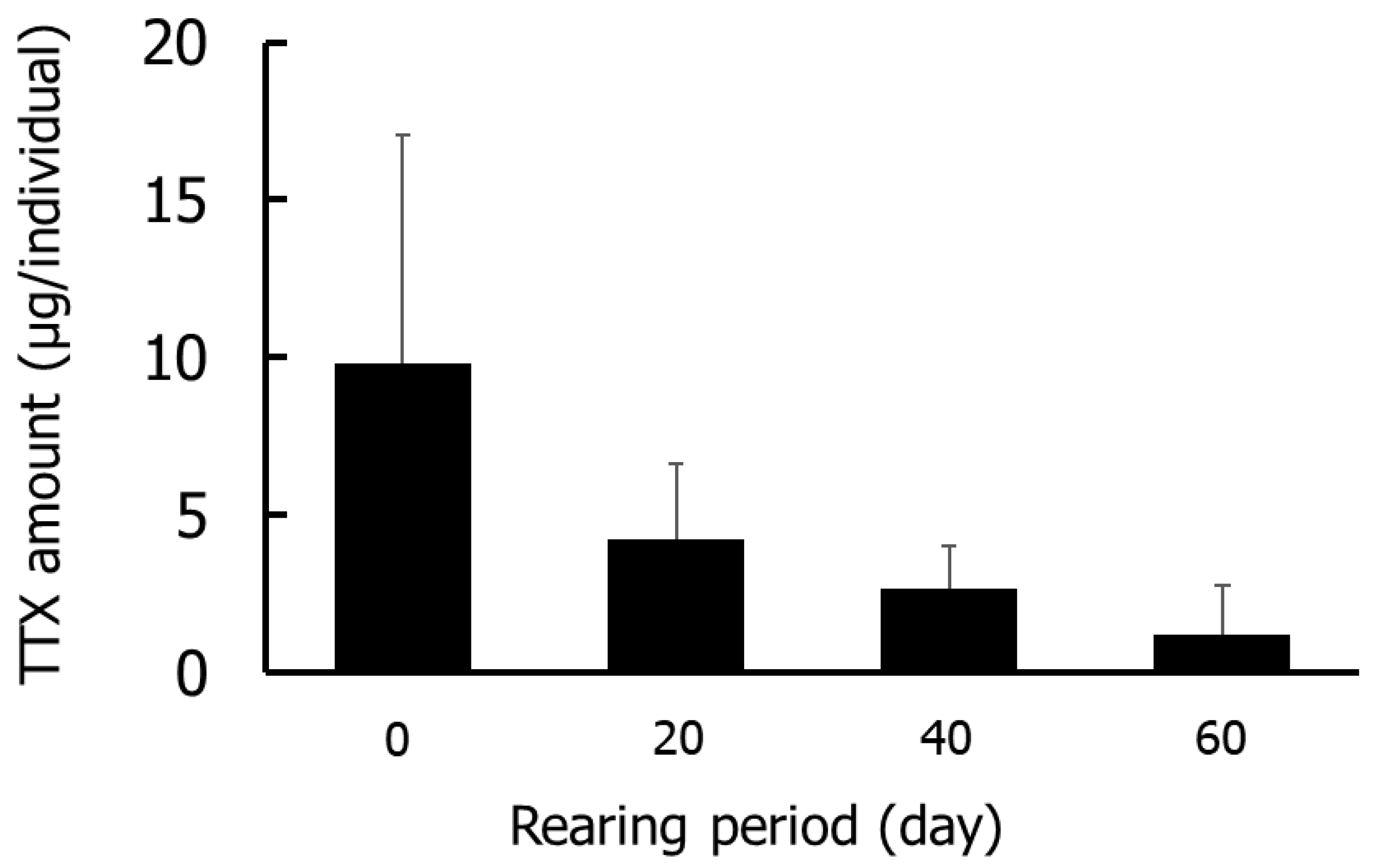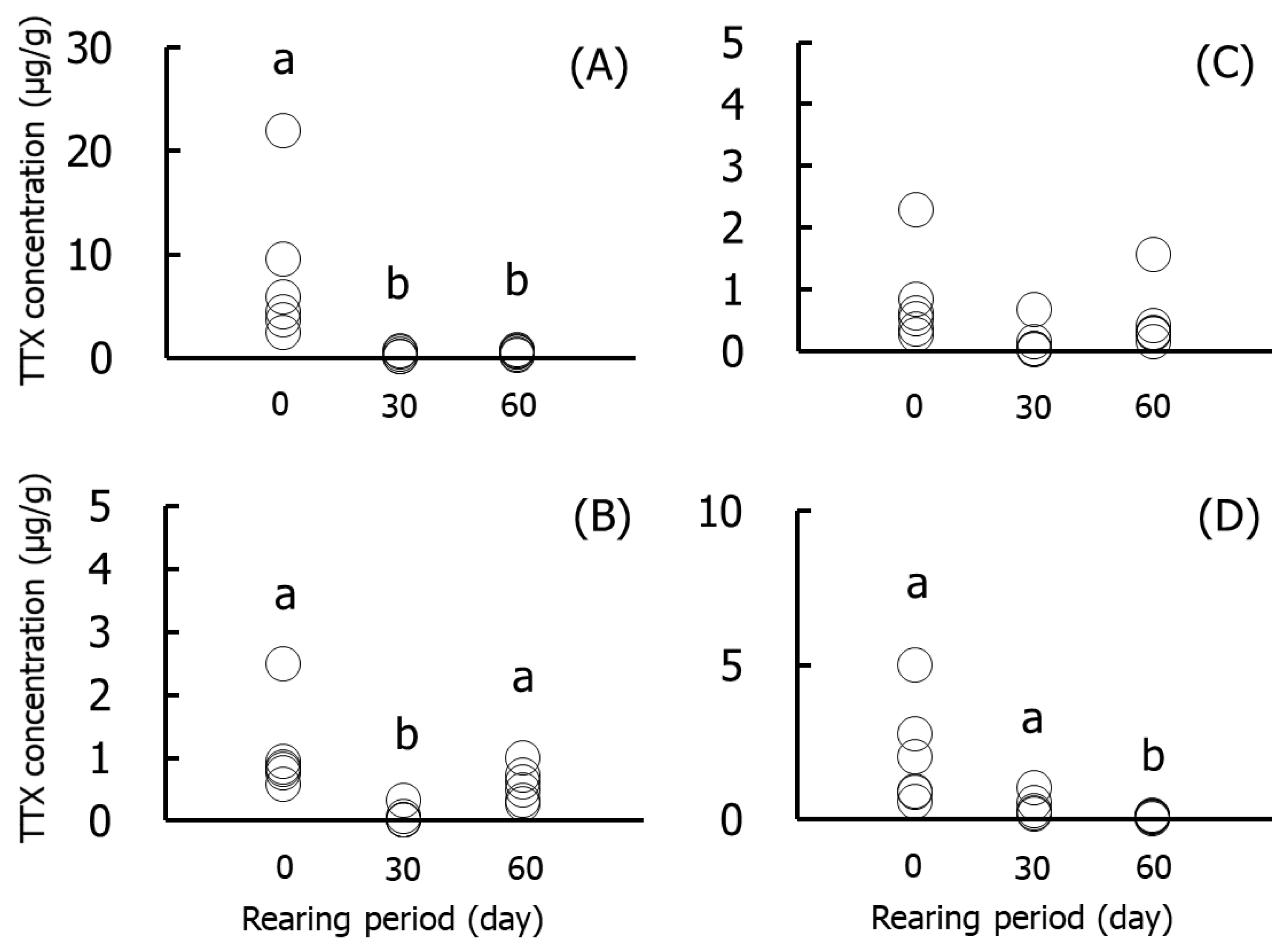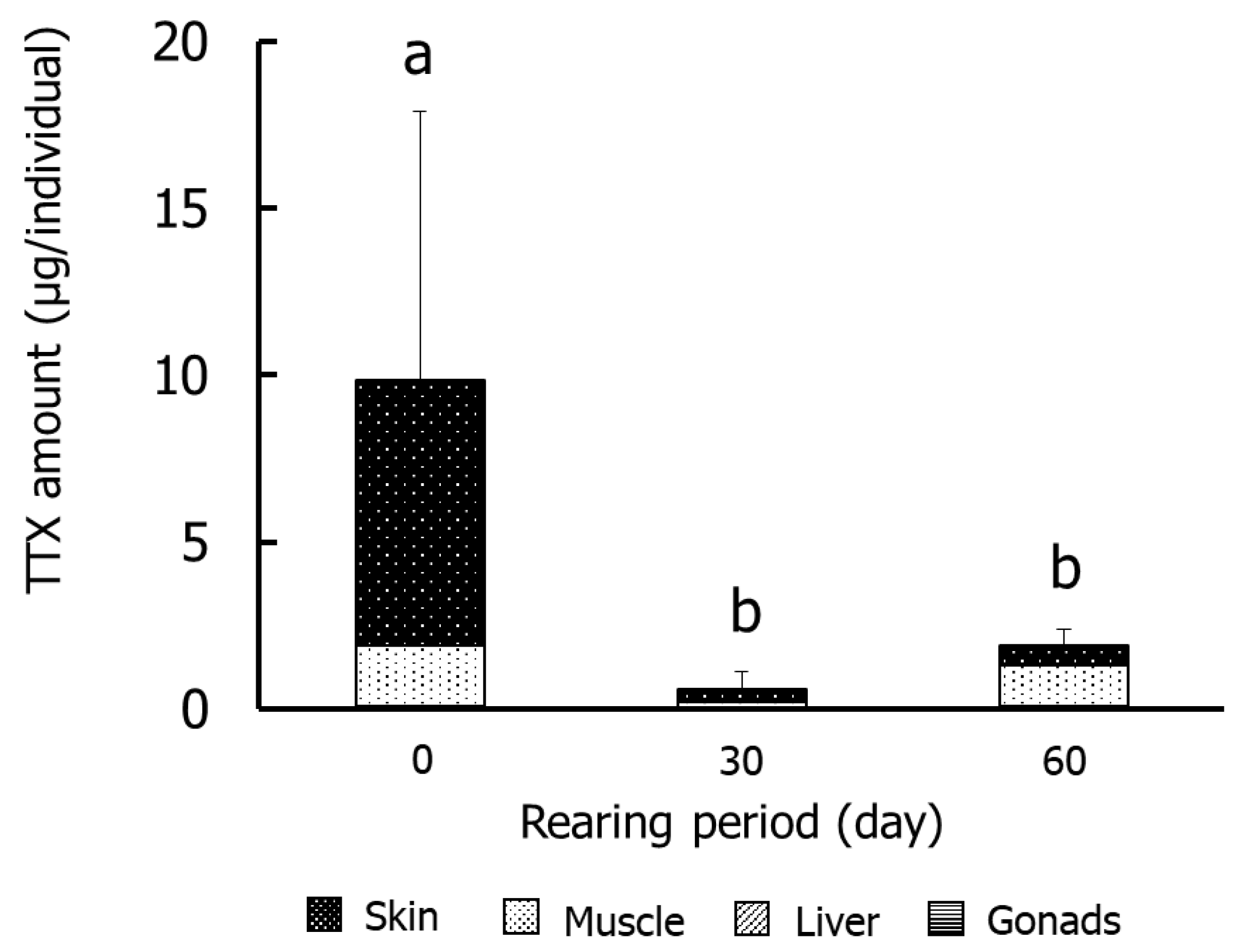Tetrodotoxin Retention in the Toxic Goby Yongeichthys criniger
Abstract
:1. Introduction
2. Materials and Methods
2.1. Goby Specimens
2.2. Rearing Experiments
2.3. TTX Quantification
2.4. Statistical Analysis
3. Results
4. Discussion
Author Contributions
Funding
Institutional Review Board Statement
Informed Consent Statement
Data Availability Statement
Acknowledgments
Conflicts of Interest
References
- Noguchi, T.; Arakawa, O. Tetrodotoxin-distribution and accumulation in aquatic organisms, and cases of human intoxication. Mar. Drugs 2008, 6, 220–242. [Google Scholar] [CrossRef] [PubMed] [Green Version]
- Shibuno, T.; Nakamura, Y.; Horinouchi, M.; Sano, M. Habitat use patterns of fishes across the mangrove-seagrass-coral reef seascape at Ishigaki Island, southern Japan. Ichthyol. Res. 2008, 55, 218–237. [Google Scholar] [CrossRef]
- Sekikawa, H.; Nanjo, K.; Mizutani, A.; Kohno, H. Ecological distribution of the toxic goby Yongeichthys criniger (Perciformes, Gobiidae) in the Urauchi river, Iriomote Island, southern Japan. Bull. Biogeogr. Soc. Jpn. 2017, 71, 109–120. [Google Scholar]
- Hashimoto, Y.; Noguchi, T. Occurrence of a tetrodotoxin-like substance in a goby Gobius criniger. Toxicon 1971, 9, 79–84. [Google Scholar] [CrossRef]
- Noguchi, T.; Hashimoto, Y. Isolation of tetrodotoxin from a goby Gobius criniger. Toxicon 1973, 11, 305–307. [Google Scholar] [CrossRef]
- Noguchi, T.; Kao, H.; Hashimoto, Y. Toxicity of the goby, Gobius criniger. Bull. Japan Soc. Sci. Fish. 1971, 37, 642–647. [Google Scholar] [CrossRef] [Green Version]
- Tatsuno, R.; Shikina, M.; Soyano, K.; Ikeda, K.; Takatani, T.; Arakawa, O. Maturation-associated changes in the internal distribution of tetrodotoxin in the female goby Yongeichthys criniger. Toxicon 2013, 63, 64–69. [Google Scholar] [CrossRef]
- Hibi, Y.; Tetsu, T.; Ochiai, Y.; Saito, T. Unexpected occurrence of fish toxification and proposed safety net. Refrigeration 2017, 92, 196–201. [Google Scholar]
- Nohara, K.; Tetsu, T.; Kohno, H.; Saito, T. Genetic population structure and tetrodotoxin content of yellowfin toxic goby Yongeichthys criniger in the Japanese coastal area. Aquat. Anim. 2019, 1–11. [Google Scholar]
- Saito, T.; Sugiura, T. Studies on toxicity a goby, Yongeichthys criniger, from Iriomote Island. Bull. Inst. Ocean. Res. Develop. Tokai Univ. 1997, 18, 35–41. [Google Scholar]
- Mahmud, Y.; Tanu, M.B.; Takatani, T.; Asayama, E.; Arakawa, O.; Noguchi, T. Chelonodon patoca, a highly toxic marine puffer in Japan. J. Nat. Toxins 2001, 10, 69–74. [Google Scholar] [PubMed]
- Nanjo, K.; Sekikawa, H.; Mizutani, A.; Kohno, H. Role of tetrodotoxin as a protection mechanism against predatory fish in the toxic goby Yongeichthys criniger: Results of laboratory experiments. Study Rev. Iriomote Is. 2017 ORRC Tokai Univ. 2018, 46–54. [Google Scholar]
- Kodama, M.; Ogata, T.; Sato, S. External secretion of tetrodotoxin from puffer fishes stimulated by electric shock. Mar. Biol. 1985, 87, 199–202. [Google Scholar] [CrossRef]
- Saito, T.; Noguchi, T.; Harada, T.; Murata, O.; Hashimoto, K. Tetrodotoxin as a biological defense agent for puffers. Bull. Jpn. Soc. Sci. Fish. 1985, 51, 1175–1180. [Google Scholar] [CrossRef]
- Saito, T.; Imakiire, M.; Kishimoto, H. Toxicity of the fertilized eggs and the parent fishes in the shadow-goby, Yongeichthys criniger, from the Iriomote Island, southern Ryukyu. Sci. Rep. Mus. Tokai Univ. 2002, 4, 79–85. [Google Scholar]
- Itoi, S.; Yoshikawa, S.; Asahina, K.; Suzuki, M.; Ishizuka, K.; Takimoto, N.; Mitsuoka, R.; Yokoyama, N.; Detake, A.; Takayanagi, C.; et al. Larval pufferfish protected by maternal tetrodotoxin. Toxicon 2014, 78, 35–40. [Google Scholar] [CrossRef] [Green Version]
- Itoi, S.; Suzuki, M.; Asahina, K.; Sawayama, E.; Nishikubo, J.; Oyama, H.; Takei, M.; Shiibashi, N.; Takatani, T.; Arakawa, O.; et al. Role of maternal tetrodotoxin in survival of larval pufferfish. Toxicon 2018, 148, 95–100. [Google Scholar] [CrossRef]
- Yamamori, K.; Kono, M.; Furukawa, K.; Matsui, T. The toxification of juvenile cultured kusafugu Takifugu niphobles by oral administration of crystalline tetrodotoxin. J. Food Hyg. Soc. Jpn. 2004, 45, 73–75. [Google Scholar] [CrossRef] [Green Version]
- Honda, S.; Arakawa, O.; Takatani, T.; Tachibana, K.; Yagi, M.; Tanigawa, A.; Noguchi, T. Toxification of cultured puffer fish Takifugu rubripes by feeding on tetrodotoxin-containing diet. Nippon Suisan Gakkaishi 2005, 71, 815–820. [Google Scholar] [CrossRef] [Green Version]
- Kono, M.; Matsui, T.; Furukawa, K.; Yotsu-Yamashita, M.; Yamamori, K. Accumulation of tetrodotoxin and 4,9-anhydrotetrodotoxin in cultured juvenile kusafugu Fugu niphobles by dietary administration of natural toxic komonfugu Fugu poecilonotus liver. Toxicon 2008, 51, 1269–1273. [Google Scholar] [CrossRef]
- Sato, S.; Kodama, M. Puffer fish toxin. In Standard Method of Analysis in Food Safety Regulation, 2015, Physical and Chemical Methods; Association, J.F.H., Ed.; Japan Food Hygiene Association: Tokyo, Japan, 2015; pp. 813–820. [Google Scholar]
- Nakashima, K.; Arakawa, O.; Taniyama, S.; Nonaka, M.; Takatani, T.; Yamamori, K.; Fuchi, Y.; Noguchi, T. Occurrence of saxitoxins as a major toxin in the ovary of a marine puffer Arothron firmamentum. Toxicon 2004, 43, 207–212. [Google Scholar] [CrossRef] [PubMed]
- Gao, W.; Kanahara, Y.; Tatsuno, R.; Soyano, K.; Nishihara, G.N.; Urata, C.; Takatani, T.; Arakawa, O. Maturation-associated changes in internal distribution and intra-ovarian microdistribution of tetrodotoxin in the pufferfish Takifugu pardalis. Fish. Sci. 2018, 84, 723–732. [Google Scholar] [CrossRef]
- Wei, F.; Ma, T.; Gong, X.; Zhang, N.; Bao, B. Identification of tetrodotoxin-producing bacteria from goby Yongeichthys criniger. Toxicon 2015, 104, 46–51. [Google Scholar] [CrossRef]
- Itoi, S.; Sato, T.; Takei, M.; Yamada, R.; Ogata, R.; Oyama, H.; Teranishi, S.; Kishiki, A.; Wada, T.; Noguchi, K.; et al. The planocerid flatworm is a main supplier of toxin to tetrodotoxin-bearing fish juveniles. Chemosphere 2020, 249, 126217. [Google Scholar] [CrossRef] [PubMed]
- Yotsu-Yamashita, M.; Sugimoto, A.; Terakawa, T.; Shoji, Y.; Miyazawa, T.; Yasumoto, T. Purification, characterization, and cDNA cloning of a novel soluble saxitoxin and tetrodotoxin binding protein from plasma of the puffer fish, Fugu pardalis. Eur. J. Biochem. 2001, 268, 5937–5946. [Google Scholar] [CrossRef]
- Yotsu-Yamashita, M.; Yamaki, H.; Okoshi, N.; Araki, N. Distribution of homologous proteins to puffer fish saxitoxin and tetrodotoxin binding protein in the plasma of puffer fish and among the tissues of Fugu pardalis examined by Western blot analysis. Toxicon 2010, 55, 1119–1124. [Google Scholar] [CrossRef]
- Yotsu-Yamashita, M.; Okoshi, N.; Watanabe, K.; Araki, N.; Yamaki, H.; Shoji, Y.; Terakawa, T. Localization of pufferfish saxitoxin and tetrodotoxin binding protein (PSTBP) in the tissues of the pufferfish, Takifugu pardalis, analyzed by immunohistochemical staining. Toxicon 2013, 72, 23–28. [Google Scholar] [CrossRef]
- Tatsuno, R.; Yamaguchi, K.; Takatani, T.; Arakawa, O. RT-PCR- and MALDI-TOF mass spectrometry-based identification and discrimination of isoforms homologous to pufferfish saxitoxin- and tetrodotoxin-binding protein in the plasma of non-toxic cultured pufferfish (Takifugu rubripes). Biosci. Biotechnol. Biochem. 2013, 77, 208–212. [Google Scholar] [CrossRef] [Green Version]
- Yotsu-Yamashita, M.; Nagaoka, Y.; Muramoto, K.; Cho, Y.; Konoki, K. Pufferfish saxitoxin and tetrodotoxin binding protein (PSTBP) analogues in the blood plasma of the pufferfish Arothron nigropunctatus, A. hispidus, A. manilensis, and Chelonodon patoca. Mar. Drugs 2018, 16, 224. [Google Scholar] [CrossRef] [Green Version]




| Rearing Day | No. | Body Length (mm) | Body Weight (g) |
|---|---|---|---|
| 0 | 1 | 34 | 0.73 |
| 2 | 35 | 0.85 | |
| 3 | 34 | 0.68 | |
| 20 | 4 | 38 | 0.85 |
| 5 | 35 | 0.77 | |
| 6 | 40 | 1.14 | |
| 40 | 7 | 42 | 1.15 |
| 8 | 42 | 1.28 | |
| 9 | 39 | 0.98 | |
| 60 | 10 | 44 | 1.51 |
| 11 | 36 | 0.73 | |
| 12 | 34 | 0.59 |
| Rearing Day | No. | Body Length (mm) | Body Weight (g) |
|---|---|---|---|
| 0 | 1 | 66 | 5.17 |
| 2 | 56 | 4.19 | |
| 3 | 64 | 5.37 | |
| 4 | 67 | 6.77 | |
| 5 | 59 | 4.84 | |
| 6 | 72 | 7.72 | |
| 30 | 7 | 77 | 8.94 |
| 8 | 77 | 9.17 | |
| 9 | 70 | 8.23 | |
| 10 | 70 | 6.89 | |
| 11 | 55 | 2.94 | |
| 60 | 12 | 71 | 7.12 |
| 13 | 75 | 9.03 | |
| 14 | 57 | 3.37 | |
| 15 | 68 | 5.46 | |
| 16 | 73 | 7.57 | |
| 17 | 77 | 8.53 |
Publisher’s Note: MDPI stays neutral with regard to jurisdictional claims in published maps and institutional affiliations. |
© 2022 by the authors. Licensee MDPI, Basel, Switzerland. This article is an open access article distributed under the terms and conditions of the Creative Commons Attribution (CC BY) license (https://creativecommons.org/licenses/by/4.0/).
Share and Cite
Tatsuno, R.; Shikina, M.; Yamamoto, Y.; Kanahara, Y.; Takatani, T.; Arakawa, O. Tetrodotoxin Retention in the Toxic Goby Yongeichthys criniger. J. Mar. Sci. Eng. 2022, 10, 191. https://doi.org/10.3390/jmse10020191
Tatsuno R, Shikina M, Yamamoto Y, Kanahara Y, Takatani T, Arakawa O. Tetrodotoxin Retention in the Toxic Goby Yongeichthys criniger. Journal of Marine Science and Engineering. 2022; 10(2):191. https://doi.org/10.3390/jmse10020191
Chicago/Turabian StyleTatsuno, Ryohei, Miwako Shikina, Yuta Yamamoto, Yoko Kanahara, Tomohiro Takatani, and Osamu Arakawa. 2022. "Tetrodotoxin Retention in the Toxic Goby Yongeichthys criniger" Journal of Marine Science and Engineering 10, no. 2: 191. https://doi.org/10.3390/jmse10020191






